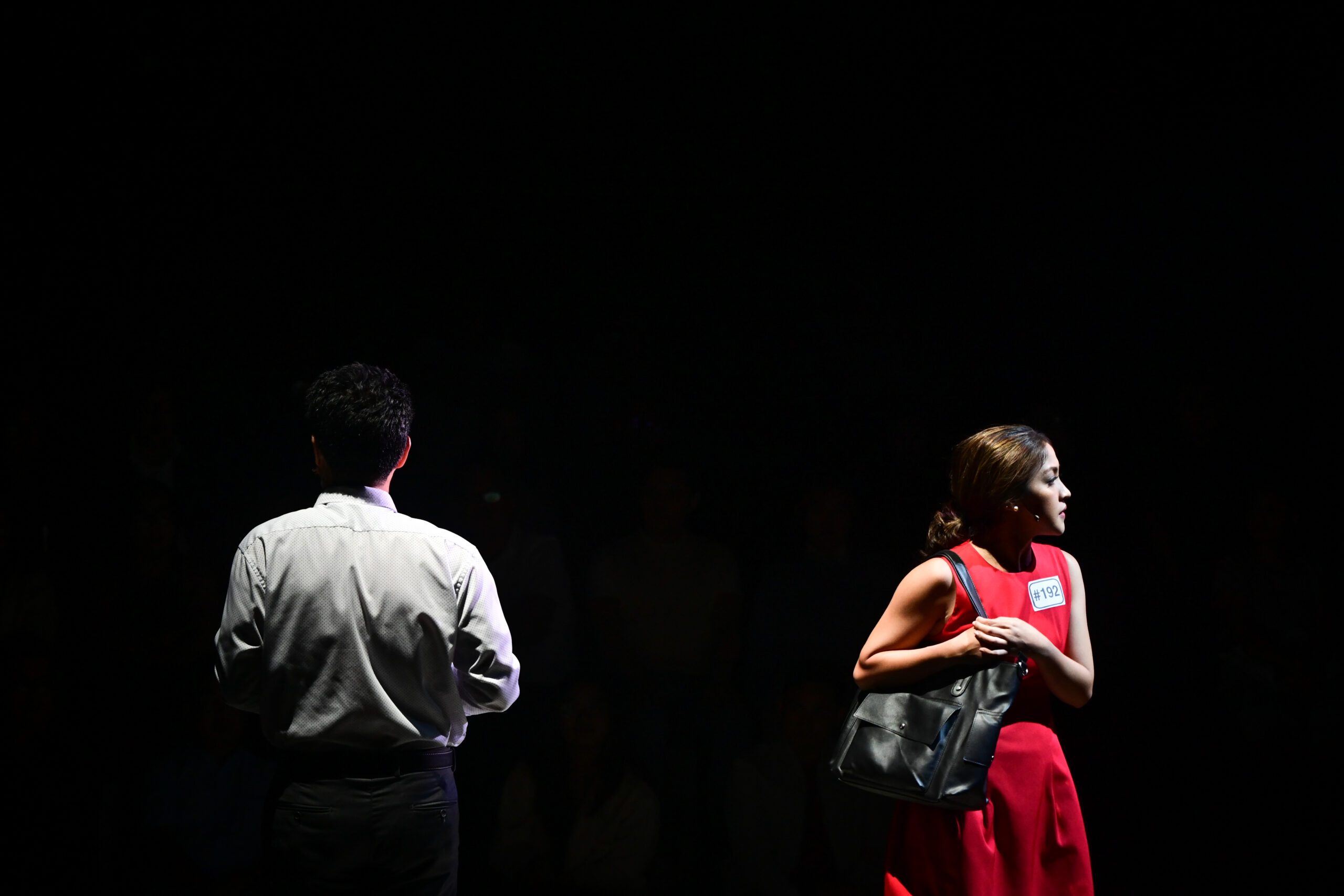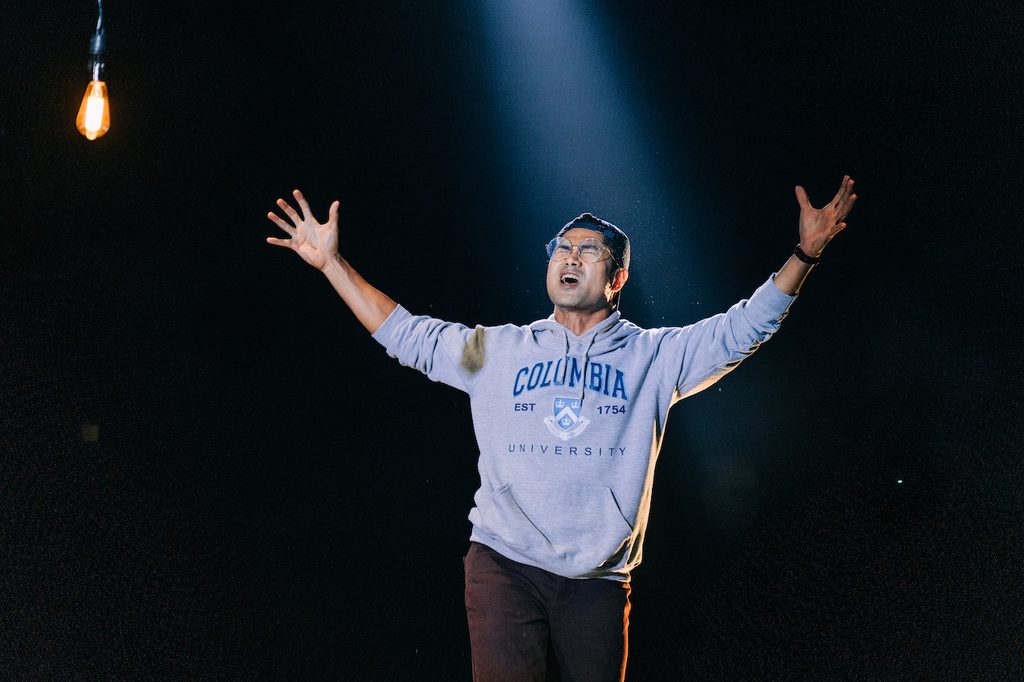SUMMARY
This is AI generated summarization, which may have errors. For context, always refer to the full article.

When Barefoot Theatre Collaborative announced that it was doing Jason Robert Brown’s The Last Five Years, there were a handful of skeptics, myself included. Apart from the countless stagings abroad and a 2014 film starring Anna Kendrick and Jeremy Jordan, it has already been staged twice before locally — the first with Menchu Lauchengco-Yulo and Audie Gemora in 2003 and the second by Nikki Gil and Joaquin Valdes in 2013. Maybe it’s tradition to stage it every 10 years, but why now?
Any apprehensions about the musical are immediately put on hold when one enters the Power Mac Center Spotlight. Director Topper Fabregas strips the material to its barest and the audience is greeted by Joey Mendoza’s beautiful set — with two lush strips of faux grass paralleling each other, separated only by a white platform that slides between them, a wooden fence doubling as a lightpiece that hangs above its protagonists. Fabregas takes cue from the music’s opposing chronologies and separates the two lovers spatially, locking them into opposite ends of the stage. The two only intermittently refer to and even converse with each other’s silhouettes, with Meliton Roxas Jr.’s lighting design creating specters out of their spouses.

In the world of musical theater, The Last Five Years has become a test of stardom. Having been performed by artists such as Cynthia Erivo and Jonathan Bailey just as they were on the cusp of their big breaks, the semi-autobiographical two-hander about a failing marriage has amassed a global cult following because it invites audiences to connect their own heartbreaks with the material. When telling the story of a failing romance, to be able to convince the audience to root for your side of the story is a quality of a true lead.
The Last Five Years lives and dies by the strength of its leads. Nearly 10 years since its last staging in the country, the production arrives with two new stars — musical theater’s new “it” couple Gab Pangilinan and Myke Salomon. With the support of a live band conducted by Rony Fortich and Fabregas’ deft eye and commitment to the truth, Pangilinan and Salomon condense a five-year relationship into a brief 90-minute affair.
Pangilinan is able to use the charm and beauty that catapulted her into one of theater’s contemporary stars and the musical’s early fare is squarely within her wheelhouse. “Still Hurting” contains the tinges of operatic pain of her Roxane in Mula sa Buwan, while “A Summer in Ohio” becomes a chance to show off her comedic chops. But she is most interesting when the text gives her opportunities to be more complex, maybe even downright unpleasant — annoying, shrill, frustrating, demanding, contemplative, gritty.
There is no moment in the show more powerful than when Pangilinan sings “Climbing Uphill” — a roughly seven-minute piece detailing the rigor of the audition process, occasionally interrupted by Jamie’s reading of his fictional bestseller The Mermaid, which serves as a self-fulfilling prophecy for their relationship. Cathy buckles under the weight of what is expected of her by producers, while simultaneously burdened to keep up with Jamie’s literary stardom.
One can’t help but find the piece metatextual, especially when one is aware of how Pangilinan struggled to have her talents validated in the mid-2010s. Pangilinan channels the desperation and despondency of her past and her peers, moving between laugh-out-loud funny and tragic, unleashing pent-up fury at the system that treats its actors as replaceable and invisible. Seeing her deliver a performance that can only be described as breathtaking in its generosity and knowing that she helped produce the conditions for her own artistic independence merits a standing ovation.

It’s easier to sympathize with Cathy’s struggles and other stagings, most notably the 2014 film by Richard LaGravenese, have opted to lean into her victimhood. But here, Fabregas and Pangilinan present a Cathy who has more bark, making every fight for relevance all the more devastating. In writing however, Jamie is the more complex character — filled with the nuances from Jason Robert Brown’s life, most of which were erased or altered for Cathy due to legal reasons. The best stagings present Jamie not as just some asshole serial cheater, but as a flawed human being whose infidelity is rooted in a deeper sadness and incompatibility, turning the material into a more dangerous portrait of how cheating is an act anyone can engage in and be guilty of.
It doesn’t help that the cards are already stacked against Salomon. Unlike Pangilinan, he has little relationship with the material and is distanced from Jamie’s background as a Jew and a novelist and this shows in his performance. He doesn’t inhabit the specificities of Jamie’s point of view, at least not at first. “Shiksa Goddess” and “Schmuel Song” are filled with frenetic energy that reveals little about Jamie’s natural gifts as a fictionist, his youthful exuberance registering more like a mask and Delphine Buencamino’s choreography, at the hands of Salomon, teeters closer to distraction than support. Even “Moving Too Fast,” while performed with vocal precision, contains little emotional depth beyond the mania from success, losing how Brown ties Jamie’s sudden stardom to the ways he recklessly enters his relationship with Cathy.
In these early numbers, one doesn’t see why Cathy would fall in love with Jamie. Not even with the way production designer Joey Mendoza and assistant costume designer Hershee Tantiado’s clothes hugs Salomon’s musculature. It is why, despite the knowledge that Pangilinan and Salomon recently married, “The Next Ten Minutes” doesn’t work. Partly because Fabregas makes the mistake of putting the two on the same plane early on in “I’m a Part of That,” decreasing the impact of when they share the space and interact. But also because Pangilinan and Salomon perform the scene with the conclusion of the song already in mind, grinning even before saying “I do,” consciously or unconsciously using their own experience as a substitute rather than imagining the anxieties that both Cathy and Jamie experience during their proposal, the clues to which are baked into the song lyrically.
Only in the latter part of the musical, when Jamie is closer to Salomon’s age and the songs become heartrending ballads, does Salomon find comfort. Maybe it’s because the material veers away from Jamie’s Jewishness and steers into the temptations that exist at the intersection of marriage and stardom, as in the hilariously performed “A Miracle Would Happen.” Here, Salomon’s animatedness works with Jamie’s failure to downplay his desires, exposing the difficulties of monogamy in a world where sex is often used to create networks and sell artistry.

But it is his “Nobody Needs To Know” that demonstrates his strengths best. Filled with quiet ease, dripping with remorse and reflection, Salomon is so precise in his rendering of self-loathing, so sure in his externalization of the relationship’s point of no return, that it becomes the production’s clearest display of Jamie’s love for Cathy, arriving ironically only when he loses her and the version of himself associated with her.
Despite its wonders, The Last Five Years only reiterates what we already know about the text and the artists staging it. But what else? And why now? It can be argued that the material touches on the instability of our acting and publishing industries — if they’re even large and organized enough to be called “industries.” Maybe it can even function as an indictment of the marriage superstructure. But even these are somewhat of a stretch.
It’s not that social relevance is a prerequisite for artistry in the Philippines. But other productions under Barefoot Theatre Collaborative have responded better to the times. Despite its flaws, Mula sa Buwan wove the precarity of the arts in Philippine society into its adaptation of Cyrano de Bergerac, while the double bill Unica Hijas and Laro served as contrasting portraits of contemporary queer life amidst internal and external conservative forces. The Last Five Years, as much as it is now considered staple in musical theater, seems more of a proof of principle of the collaborative’s power — showing that it not only has the resources to create and execute art at a high caliber, but that it can bring audiences into theaters while compensating its artists fairly.
Considering it is now one of the epicenters of theater in Manila, Barefoot now has the added responsibility of audience development. It needs to be more purposeful in its artistic decisions, brave in its risks in form and narrative, and clearer in the ways it contextualizes and connects its work to a larger body of theater in the Philippines. The Last Five Years demonstrates that it is more than capable of taking on this challenge; that it can introduce stories, forms, and talents confined to the periphery of the peripheries. If it refuses this de facto role, then it will become just like many other works in the Philippines — passion projects we are all compelled to support. – Rappler.com
Barefoot Theater Collaborative’s ‘The Last Five Years’ runs at the Power Mac Center Spotlight Blackbox Theater until October 29.
Add a comment
How does this make you feel?
There are no comments yet. Add your comment to start the conversation.